Fertilization and its Types | Additional Study Material for NEET PDF Download
| Table of contents |

|
| What is Fertilization |

|
| Site of Fertilization |

|
| Types of Fertilization |

|
| Mechanism |

|
| Significance of Fertilization |

|
What is Fertilization
The process in which union of male and female gametes (formed by gametogenesis) and fusion of pro-nuclei of sperm and ovum takes place thus diploid zygote is formed, is called fertilization.
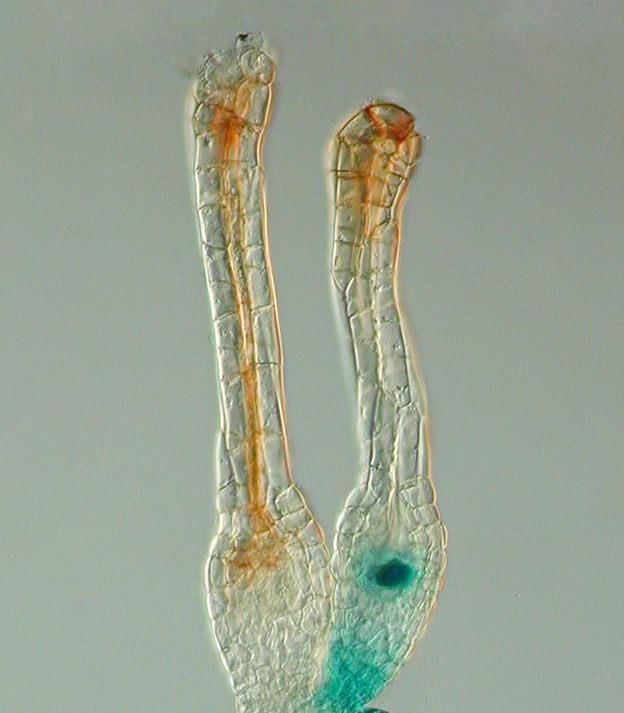 In the Bryophyte land plants, fertilization takes place within the archegonium
In the Bryophyte land plants, fertilization takes place within the archegonium
Fertilization has the following processes:
- The union of male and female gametes is called Syngamy, whereas intermixing of their cytoplasm is called plasmogamy.
- The fusion of pro-nuclei of sperm and ovum is called karyogamy.
- The intermingling of their chromosomes is called amphimixis.
- Due to fertilization, a diploid zygote is formed, by the union of two different types of gametes.
Site of Fertilization
1. Internal Fertilization
- Fertilization in the body (i.e., genital organs of animal) is called internal fertilization.
- In this type of fertilization, sperms are discharged by male directly into the genital tract of female after coitus.
- Whole process of fertilization takes place within the body of female.
- This is the most common adaptation in terrestrial animals.
Examples: Aschelminthes, reptiles, birds and mammals.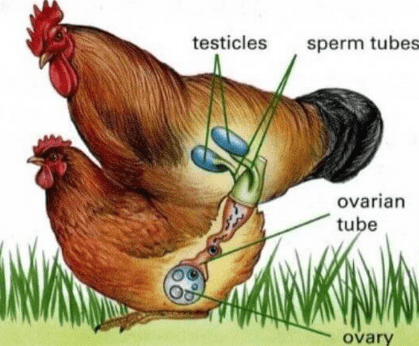 Internal Fertilization
Internal Fertilization
2. External Fertilization
- External fertilization takes place outside the body of females i.e, in water.
Examples: In most of the invertebrates, some protochordate, amphibia, and most of the fishes.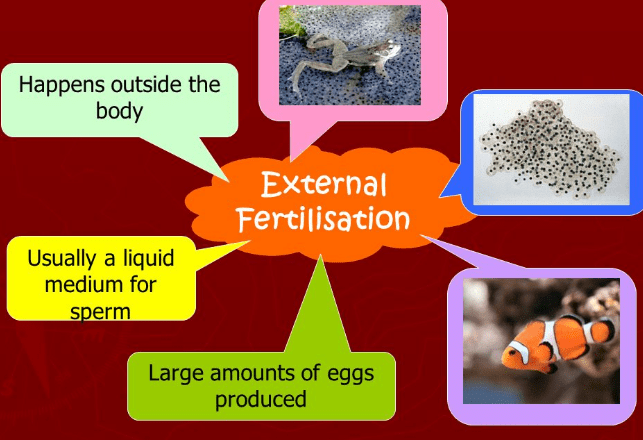
Types of Fertilization
- Self-Fertilization: This process takes place in the body of single animal i.e, fusion of male and female gametes produced by male and female organs of the same animal. This is called self-fertilization. This is possible only in bisexual or hermaphrodite animals.
Examples: Taenia solium - Cross-Fertilization: Fertilization takes place between two (male & female) different animals of same species. This is called cross-fertilization. This process is found in all unisexual animals. These animals are also called dioecious animals. Cross-fertilization is also found in most of the bisexual or hermaphrodite animals because in these animals male genital organs develop first. This condition is called protandrous condition. In some of the species female organs develop first, this condition is called protogynous condition.
Example: Sponges
Mechanism
We can understand the process of fertilization in following steps:
- Movement of sperms towards ovum.
- Entrance of sperms in the ovum.
- Activation of ovum.
1. Approach of Sperm towards the Egg
- It is a chance factor, so sperms perform random (directionless) movement.
- To increase the chances of approach of sperm towards egg there are mainly two adaptation.
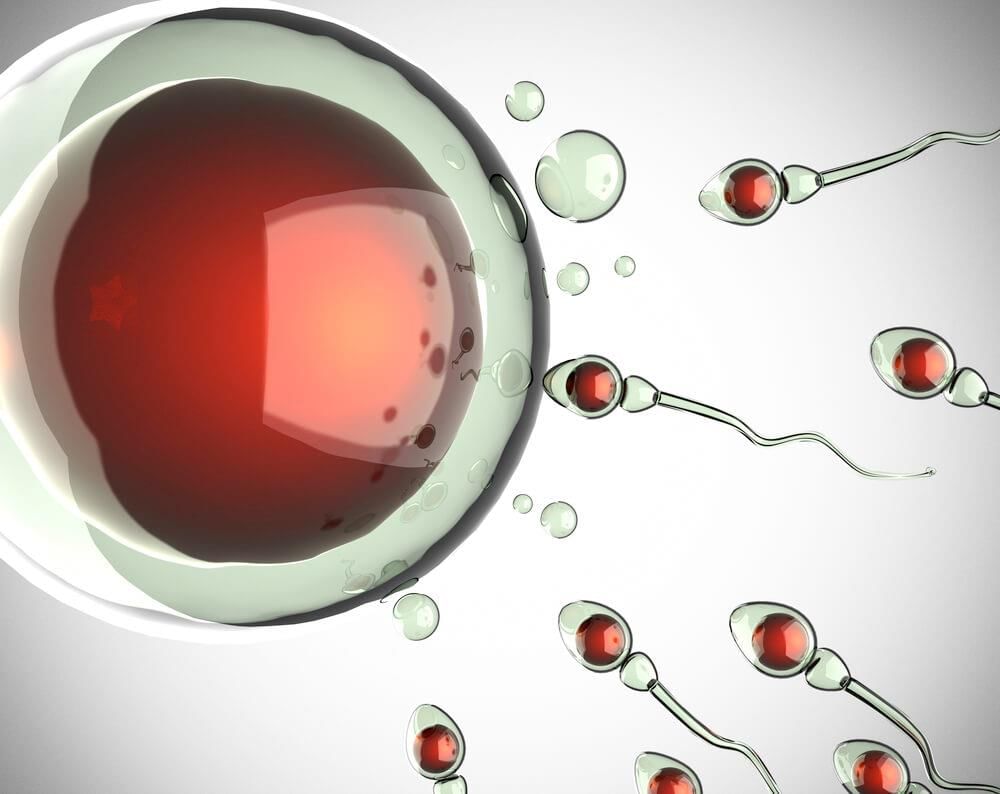 Sperms reaching egg
Sperms reaching egg
(i) Number of sperms is very high: In man 20 to 120 million sperms are present per cubic mm of semen.
(ii) Egg is 1000 times larger than sperm: Some special proteins are found on the surface of egg and sperm to help in fertilization.
2. Entrance of Sperms in the Ovum
- According to Lillie, chemicals named as "fertilizins" are found on the surface of egg. Fertilizins are glycoproteins or acid mucopolysaccharides.
- According to Ballinsky, an acidic protein named as Antifertilizin is present on the surface of sperms. "Fertilin" proteins are also present on sperm surface.
- Both the proteins are specific for a particular species. Antifertilizin present on sperm of a particular species will react with fertilizin present on egg of the same species of animals.
- If we place some eggs of sea-urchin in sea-water, this seawater becomes viscous, this is called egg-water.
- When some sperms come in contact with this egg water, sperms adhere with each other. It is called agglutination.
- Here the reaction of fertilizin (dissolved in water from egg) and antifertilizin of sperm is observed clearly.
- Fertilizins behave like lock and antifertilizins behave like keys.
- Fertilization is always intraspecific.
- According to Washerman and Sailing (1989) a specific pair of protein molecules is found on the surface of mammalian sperm, which can recognize specific carbohydrates and proteins in ZP3 region of zona pellucida.
- The binding protein of sperm reacts with these molecules to initiate the changes in acrosome. A specific sugar galactose remains attached with ZP3 glycoprotein.
- The sperm fails to recognise the ovum of its own species if this sugar is removed from zona pellucida.
In addition to these glycoproteins, there are some hormones also, which help in fertilization:
- The hormones present at the surface of sperm are called androgamones. These are of two types:
(i) Androgamone I
(ii) Androgamone II - Androgamones I help in the energy conservation of sperms.
- Androgamones II dissolve the gelatinous covering present all over the egg.
Hormones present at the surface of egg are called gyanogamones these are of 2 types:
(i) Gyanogamones I - this hormone neutralizes Androgamone I and activates sperm to move
(ii) Gyanogamones II - It makes sperm head sticky.
- Enzyme of acrosome (Hyaluronidase and sperm lysins) dissolve the egg membrane. This is called acrosomal reaction. As the result sperm head make the contact with the plasma membrane of egg, now inner membrane of acrosome evaginates outside and form rigid tube is called acrosomal filament.
- Acrosomal filament provide stimulus to plasma membrane of egg and due to stimulus of sperm, egg is induce for fertilization.
- Mammalian sperms do not form this type of filament because mammalian sperms are highly active and provide stimulus to plasma-membrane of egg without any filament.
Mammalian sperms acquire activity at two places:
(i) Epididymis
(ii) Vagina
Vaginal secretion make the sperm highly active and sperm acquire capacity of fertilization is called capacitation.
3. Activation of Egg
- Due to stimulus of sperm an enzyme is induced in plasma membrane of egg it is called adenyl cyclase enzyme and function of this enzyme is to catalyze C-AMP in egg cytoplasm.
- C-AMP is the second messenger.
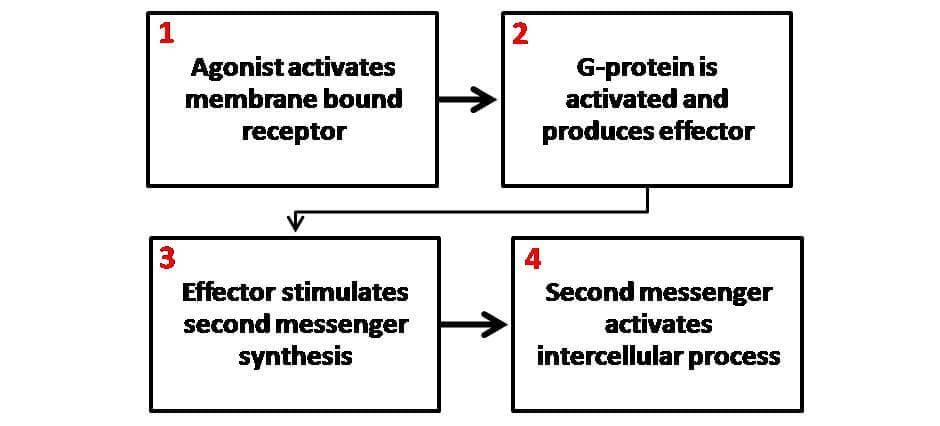 General Schematic of Second Messenger Mechanism
General Schematic of Second Messenger Mechanism - Cyclic AMP receives stimulus from plasma membrane of egg and transfers it in egg cytoplasm and induces all the response of egg for sperm.
- All the response of egg for sperm are collectively called gynogenesis.
- Due to stimulus of sperm, permeability of plasma membrane of egg increases specially for k+ and Ca2+ ions.
- Function of Ca2+ ions is to inactivate the cytostatic factors in egg. As a result egg is now ready for cleavage (In egg cytoplasm special type of protein called cytostatic factor are present these factors prevent the cleavage in unfertilized egg.
- Due to stimulus of sperm, H+- Na+ pump activates and induces the plasma-membrane of egg. Function of this pump is to continuously influx H+ ions and out-flux Na+ions. As a result concentration of H+ ion increases in egg cytoplasm and develops an acidic medium.
- In acidic medium, proteolytic enzyme become active and liberate the m-RNA from informosome. These m-RNA become active and rapidly synthesize different types of protein and enzymes. Due to more availability of protein and enzymes metabolic activity of egg increases.
Response of Egg
- Due to stimulus of sperm, meiosis-II is induced in human egg by excluding second polar body becoming mature ovum.
- At the point of contact with sperm and plasma membrane of egg a cone-like structure is formed called reception cone. After some time reception cone sinks in egg cytoplasm along with sperm (entry of sperm is a type of phagocytosis).
- With the entry of sperm all the cortical granules burst and secrete a membrane around the egg is called fertilization membrane (cortical reaction). It is secreted on inner surface of primary egg membrane and perivitelline space become more wide and amount of perivitelline fluid is also increase.
- Function of perivitelline fluid and fertilization membrane is to prevent the entry of sperm in egg. so normally only one sperm enter inside the egg (monospermy). Sometimes more than one sperm enter inside the egg (polyspermy).
Two types of polyspermy are found in nature:
- Pathological Polyspermy: In it the nuclei of all the sperms fuse with egg nucleus. In such type of condition embryo development does not occur. (Due to polyploidy condition).
- Physiological Polyspermy: In physiological polyspermy nucleus of only one sperm fuses with egg nucleus and rest of the sperm die in egg cytoplasm. Dead sperm are called merocytes. In physiological polyspermy, normal embryo development occurs. Polyspermy is absent in human beings. Polyspermy mostly occurs in megalecithal eggs. Fertilization membrane and cortical granules are absent in egg rat & guinea pig.
Fate of Sperm in Egg
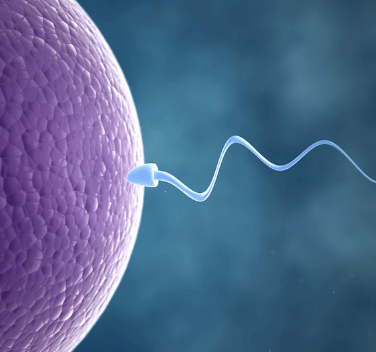 Sperm going inside the Egg
Sperm going inside the Egg
- In majority of animals, only head and middle piece enter inside the egg and tail is left outside.
- In mammals, whole sperm enters in the egg.
- In some animals, only head of sperm enters in the egg tail and middle piece remain outside e.g. Hydra, Neries etc.
- After entering inside the egg, sperm rotates by 1800. All the structures of sperm dissolve in egg cytoplasm except sperm nucleus and proximal centriole.
- The centriole of egg itself degenerates at the time of second maturation division. So proximal centriole of sperm starts division, it divides into 2 daughter centrioles, which migrate towards opposite pole and start forming spindles.
Fate of Sperm Nucleus
- The nucleus of sperm absorbs water from egg cytoplasm and becomes enlarged. Now it is called male pro-nucleus.
- After meiosis - II egg nucleus occur in the form of scattered vesicles then it is called as karyomeres and after some time all the karyomeres assembled to form complete nucleus is called female pronucleus.
- Male pronucleus and female pronucleus migrate through definite routes and come close to each other. These routes are called fertilization path.
It has following parts:
(i) Sperm penetration path: Male pronucleus for some distance, moves at the equator of egg. This is called sperm penetration path.
(ii) Sperm copulation path: Male pronucleus starts migrating towards female pronucleus.
(iii) Egg copulation path: Female pronucleus migrates towards male pronucleus. Both the pronuclei come close to each other.
(iv) Cleavage path: Both the pronuclei move together to their final position which is somewhere in animal pole. At this final position nuclear membrane of both the pronuclei degenerate and chromosomes of male and female pronuclei form pairs. The mixture of male and female chromosomes is called amphimixis. - Amphimixis was discovered by O.Hertwig in the eggs of sea - urchin.
- Newport was of all first observed the entry of sperm into the egg.
Significance of Fertilization
- Oocyte completes its second maturation division on coming in contact with the sperm.
- The Amphimixis process leads to the formation of a diploid zygote to restore the normal diploid number of the chromosomes.
- The centriole of sperm after entering into egg induces the egg to undergo cleavage.
- The paternal and maternal characters are transmitted to the offsprings through the process of fertilization.
- The peripheral changes occurring in the egg prevent the further entry of sperm into the ovum, thus checking polyspermy.
|
26 videos|312 docs|64 tests
|
FAQs on Fertilization and its Types - Additional Study Material for NEET
| 1. What is fertilization? |  |
| 2. Where does fertilization take place? |  |
| 3. What are the types of fertilization? |  |
| 4. What is the mechanism of fertilization? |  |
| 5. What is the significance of fertilization? |  |





















